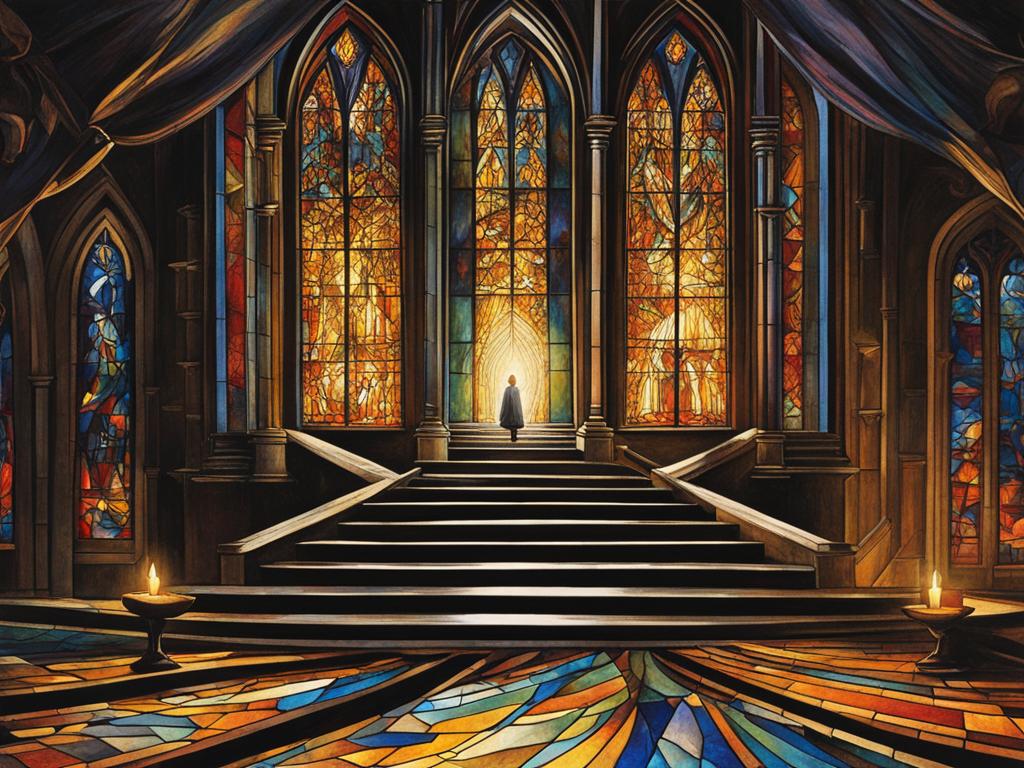No products in the cart.
The Spiritual Significance of Churches and Cathedrals
This post contains paid and/or affiliate links. I make a small commission at no extra cost to you. Please see our Privacy Policy.
The churches’ and cathedrals’ spiritual value, as symbols of religion and worship, these hallowed places are incredibly significant to believers. This post will explore these architectural marvels’ profound spiritual significance and place in our religious traditions.
The Symbolism of Church Architecture and Design
In church architecture and design, symbolism plays a significant role in conveying profound spiritual truths and beliefs. Every aspect of a church’s layout and orientation has deep meaning and symbolism, reminding worshipers of their connection to the divine.
The Layout and Orientation
- The basilica form and east-west axis of cathedrals symbolize the earthly church’s connection to Jerusalem and the ancient Temple, representing the sacredness of the space.
The West Portal
- The west portal, flanked by towering structures, holds symbolic significance. It represents the end of time, the entrance to the heavenly sanctuary, and the journey towards salvation.
Light, Color, and Stained Glass Windows
- The strategic use of light, vibrant colors, and intricately designed stained glass windows create a heavenly and transcendent atmosphere, evoking a sense of awe and wonder. These elements remind worshipers of the New Jerusalem, a place of ultimate beauty and divine presence.
The Grandeur and Height of the Nave
- The grandeur and height of the nave draw attention upwards, directing the focus of worshipers towards the divine. It symbolizes the transcendence and magnitude of God, inspiring a sense of reverence and reflection.
The symbolism inherent in church architecture and design enriches the spiritual experience and deepens the connection between individuals and their faith. It serves as a visual representation of divine truths and beliefs, inviting worshipers to contemplate their place within the grand tapestry of the spiritual realm.
The Role of Beauty in Catholic Worship
The Catholic Church places great importance on the role of beauty in its worship. Beauty is a powerful tool for evangelization and communication, reaching believers and nonbelievers alike. In Catholic worship, beauty takes center stage, captivating the senses and inspiring a profound encounter with the divine.
One of the most striking expressions of beauty within Catholic worship is found in the aesthetic grandeur of cathedrals. These sacred spaces are adorned with intricate art, exquisite sculptures, and breathtaking stained glass windows. Every detail is crafted with utmost care and precision, reflecting the devotion and love of countless artisans throughout history.
This aesthetic beauty serves a more profound purpose beyond mere decoration. It enhances the liturgical celebration, enveloping worshipers in an atmosphere of sacredness and reverence. The play of light through stained glass windows, the harmonious blending of colors, and the exquisite depictions of religious scenes draw the faithful into a deeper awareness of the transcendent and invite them to encounter the divine.
Beauty as a Gateway to Transcendence
Beauty has a unique way of speaking to the human soul, stirring the heart and inspiring awe. In Catholic worship, beauty is a powerful form of evangelization, captivating believers and nonbelievers and drawing them closer to the mystery of faith.
- Evoking the Transcendent: The beauty in cathedrals transcends the material world, pointing to the realm of the divine. The grandeur and architectural splendor of these sacred spaces lift the gaze upward, reminding worshipers of the heavenly kingdom and inviting them to contemplate the majesty of God.
- Uplifting the Spirit: The aesthetic beauty of cathedrals has the power to uplift the spirits of the faithful, inspiring them to aspire towards beauty, goodness, and truth in their own lives. It serves as a visual reminder of the ideal, stirring the soul to seek a deeper relationship with God and to live according to His commandments.
- Inviting Encounter: The beauty found in worship spaces beckons individuals to encounter the divine personally and creatively. It creates an environment conducive to prayer, reflection, and contemplation, nurturing a sense of awe and wonder in the presence of God.
By embracing and incorporating beauty into its worship, the Catholic Church recognizes its power to touch the human spirit and awaken a longing for the transcendent. Through the experience of beauty, believers can encounter the divine and be drawn into a deeper relationship with God.
The Historical and Cultural Significance of Cathedrals
Cathedrals hold a unique place in our history and culture, encompassing their role as places of worship and as significant landmarks. These magnificent structures bear witness to the unwavering faith of generations past and present, serving as a testament to the Church’s enduring commitment to proclaiming the Gospel throughout history.
The architectural splendor and artistic treasures found within cathedrals exemplify the creative brilliance of their time, reflecting the cultural and historical contexts in which they were built. From their soaring spires to intricate stone carvings, each element tells a story of devotion, craftsmanship, and artistic expression.
Historical Significance
- Cathedrals provide invaluable insights into different eras’ architectural and engineering achievements, showcasing the progression of design styles and techniques across centuries.
- They serve as landmarks that have stood the test of time, witnessing significant historical events and milestones, including coronations, royal weddings, and religious ceremonies.
- As enduring symbols of community and societal development, cathedrals often stand as focal points of cities and towns.
Cultural Significance
- Cathedrals form an integral part of cultural identity, representing a region or nation’s shared heritage and religious traditions.
- They house priceless works of art, including intricate stained glass windows, ornate altars, and magnificent sculptures that exemplify the creativity and aesthetic sensibilities of the time.
- Cathedrals connect to significant historical personalities and events and contribute to a society’s collective memory and cultural narrative.
By meticulously preserving and maintaining these architectural wonders, the Church ensures that future generations can appreciate their historical and cultural significance. Cathedrals inspire awe and reverence, inviting believers and nonbelievers to explore their profound impact on our past, present, and future.
Conclusion
Churches and cathedrals possess a spiritual significance that profoundly resonates with believers. These sacred spaces provide individuals with a profound connection to the divine, allowing them to encounter the beauty and magnificence of God. The symbolism, architecture, and art within these hallowed walls are visual reminders of the transcendent, inspiring worshipers to forge a deeper relationship with their faith.
By immersing ourselves in the spiritual significance of churches and cathedrals, we are reminded of the riches and splendor of our religious traditions. These places of worship tap into our collective heritage and offer a glimpse into the profound devotion of generations past, guiding us toward spiritual enlightenment and awakening.
Strolling through the majestic halls and gazing upon the awe-inspiring architecture, we are transported to a realm where heaven meets earth. The sanctity and serenity enveloping these spaces invite us to seek solace, find answers, and experience a sense of renewal. Churches and cathedrals stand as testaments to faith, evoking a deep reverence and awe that transcends time and space.
FAQ
What is the spiritual significance of churches and cathedrals?
Churches and cathedrals hold a profound spiritual significance for believers. They are places where individuals can experience a deep connection with the divine and encounter the beauty and majesty of God.
What do the architecture and design of churches symbolize?
The architecture and design of churches symbolize spiritual truths and beliefs. The layout and orientation of cathedrals, with their basilica form and east-west axis, symbolize the connection of the earthly church to Jerusalem and the ancient Temple. The west portal, flanked by towers, signifies the end of time and the entrance to the heavenly sanctuary. Light, color, and stained glass windows create a heavenly and transcendent atmosphere, reminding worshipers of the New Jerusalem. The grandeur and height of the nave direct attention upwards, drawing people’s focus to the divine.
What is the role of beauty in Catholic worship?
The Catholic Church places great importance on the role of beauty in its worship. Beauty is seen as a means to evangelize and communicate the faith to believers and nonbelievers alike. Cathedrals’ aesthetic beauty, intricate art, sculptures, and stained glass windows enhance the liturgical celebration and create an atmosphere of sacredness and reverence. The Church sees beauty as a powerful tool to inspire and uplift the faithful, evoking a sense of transcendence and inviting them to encounter the divine.
What is the historical and cultural significance of cathedrals?
Cathedrals are not only places of worship but also historical and cultural landmarks. They are living testimonies to the faith of generations past and present, embodying the commitment of the Church to proclaim the Gospel throughout history. The architectural beauty and artistic treasures found in cathedrals, often representing the creative genius of their time, serve as a source of inspiration and a connection to our religious heritage. By preserving and maintaining these sacred spaces, the Church ensures that future generations can appreciate these architectural wonders’ historical and cultural significance.
Why are churches and cathedrals important in our religious traditions?
Churches and cathedrals hold a deep spiritual significance and serve as a visual reminder of the transcendent. They inspire worshipers to seek a deeper relationship with their faith. Additionally, cathedrals are historical and cultural landmarks representing our religious traditions’ rich heritage and beauty.












